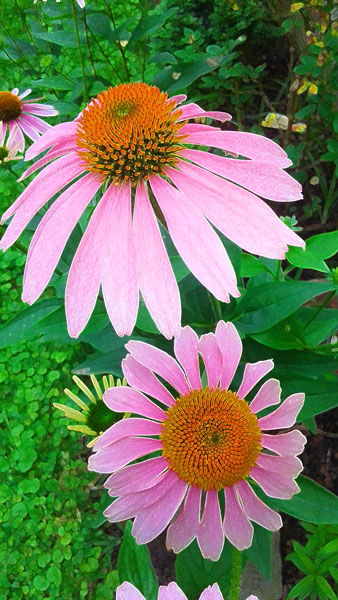
By Linda Wiggen Kraft
A garden is not only plants, it is a network of life forms and forces. It is the community, communication and communing of plants, insects, birds, soil, sun, rain and all parts of the ecosystem called garden. Each part is in relationship. The strongest relationships are those that give life and support to each other and the whole community.
The network of native plants, insects, birds and other parts of the garden form the strongest community because they have evolved over eons to support each other and live together. Native trees, shrubs and plants evolved to be the life support of native insects and birds. The insects pollinate the plants and are protein necessary for bird survival. The birds keep the insects in check protecting food and forest crops. They also find shelter and food in the plants. It’s a cycle, a life cycle. When non-native plants are part of the garden, the community is weakened. Most often non-native plants are not food for insects, therefore they don’t provide food for birds. Native butterflies and moths that dance in our gardens have evolved to survive on specific plants. If these insects do not have those plants they will perish. A case in point is our beloved Monarch butterfly that only survives on asclepias (milkweed) plants. No more asclepias, no more Monarchs. And this is exactly what is happening with the decline of the asclepias plants along the route Monarchs take to winter in Mexico. The steep decline in Monarchs corresponds to the steep decline in asclepias.
We can grow native trees, shrubs and plants in our gardens to strengthen the native network and life of the garden. There are online resources that share information about the community of specific plants to specific insects and bird life. The National Wildlife Federation has a website showing what native insects are kept alive by specific native plants – (www.nwf.org/ NativePlantFinder/). And Audubon Society has a website linking native plants to birds – (www.audubon.org/native-plants)
The National Wildlife Federation’s site states: “Find the best native plants to help wildlife – based on the research of Dr. Doug Tallamay.” Dr. Tallamay has written perhaps the best book on how important native plants are for the native network of insects, birds and other life, titled “Bringing Nature Home”. This website uses his research and selects plants selected by zip codes to provide ranked lists of plants. The ranking is based on the number of butterflies and moths caterpillars that live on a host plant. These caterpillars can survive only on these specific plants. Number one on the list for our area is the oak tree, which is the host plant for 429 species of butterflies and moths. Goldenrod is the top ranked perennial, supporting 97 species of butterflies and moths. Other natives are also hosts to caterpillars. A favorite native perennial is Echinacea (purple coneflower). Although it is host for only one moth, the sunflower moth, it is a magnet for yellow finches as the flower turns to seed.
Birds rely on plants for shelter, insects, berries and seeds. Audubon Society’s website matches birds to specific plants. Sorted by zip code, the list shows birds attracted to specific native plants for shelter and food. An example is Echinacea, which attracts finches, crows, jays, cardinals, grosbeaks, chickadees and sparrows. Oak trees are shown to attract up to 18 bird species for shelter, caterpillars and acorns.
When growing trees, shrubs and perennials in your garden think of the native network and how you can help support and be part of the community and life force of this network.
Linda Wiggen Kraft is a landscape designer who creates holistic and organic gardens. She is also a mandala artist and workshop leader. Please Visit her blog online at: www.CreativityForTheSoul.com/blog or her website: www.CreativityForTheSoul.com. Call her at (314) 504-4266.


